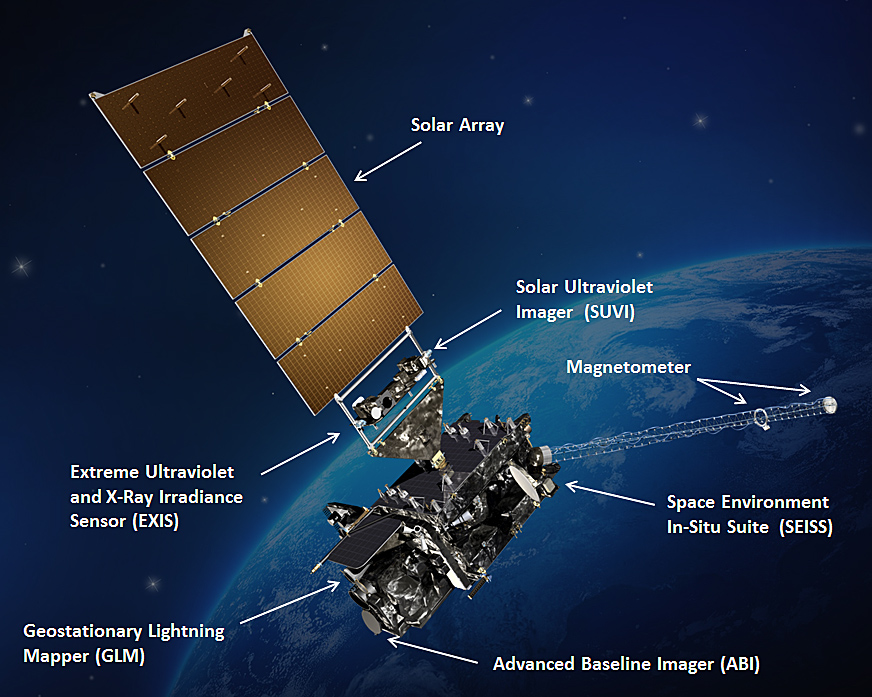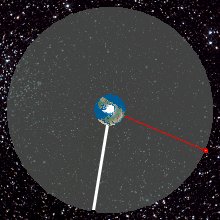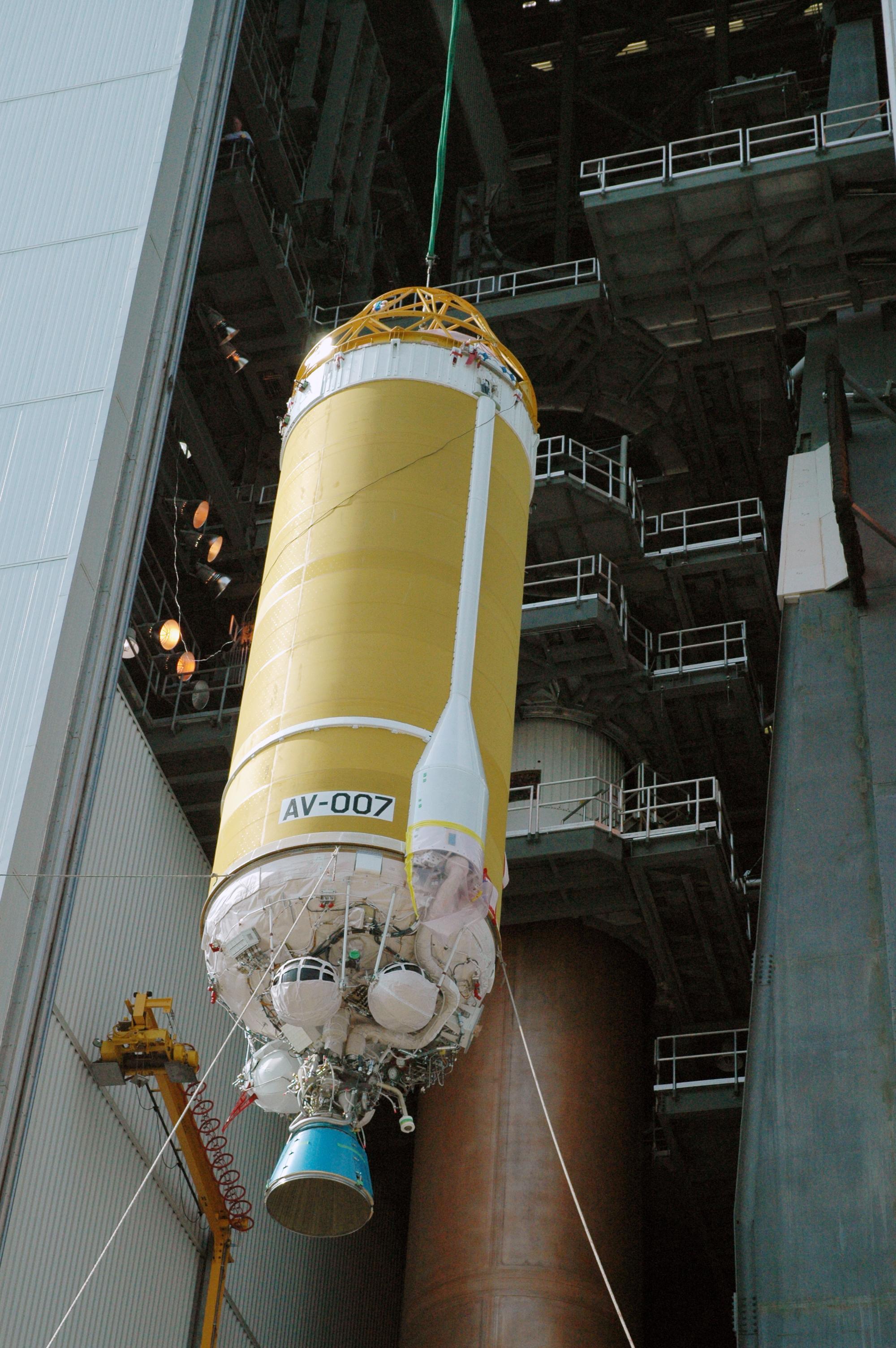|
GOES 12
GOES-12, known as GOES-M before becoming operational, is an American weather satellite, which is part of the US National Oceanic and Atmospheric Administration's Geostationary Operational Environmental Satellite system. It was launched on July 23, 2001, and spent its first 21 months in space as an on-orbit spare. From April 2003, the satellite took over the GOES-East position, providing coverage of the eastern half of the continental United States. In April 2010, GOES-East operations were taken over by GOES-13, and GOES-12 transitioned to the GOES-South location to devote time to South American imagery. It remained at this post until it was decommissioned on August 16, 2013 and subsequently boosted to a graveyard orbit. Launch GOES-M was launched aboard an International Launch Services Atlas IIA rocket, flying from Space Launch Complex 36A at the Cape Canaveral Air Force Station. The launch occurred at 07:23 GMT on 23 July 2001, having previously been delayed eight days; seven ... [...More Info...] [...Related Items...] OR: [Wikipedia] [Google] [Baidu] |
Weather Satellite
A weather satellite or meteorological satellite is a type of Earth observation satellite that is primarily used to monitor the weather and climate of the Earth. Satellites are mainly of two types: polar orbiting (covering the entire Earth asynchronously) or geostationary (hovering over the same spot on the equator). While primarily used to detect the development and movement of storm systems and other cloud patterns, meteorological satellites can also detect other phenomena such as city lights, fires, effects of pollution, auroras, sand and dust storms, snow cover, ice mapping, boundaries of ocean currents, and energy flows. Other types of environmental information are collected using weather satellites. Weather satellite images helped in monitoring the volcanic ash cloud from Mount St. Helens and activity from other volcanoes such as Mount Etna. Smoke from fires in the western United States such as Colorado and Utah have also been monitored. El Niño and its effects on wea ... [...More Info...] [...Related Items...] OR: [Wikipedia] [Google] [Baidu] |
GOES 13
EWS-G1 (Electro-optical Infrared Weather System Geostationary) is a weather satellite of the U.S. Space Force, formerly GOES-13 (also known as GOES-N before becoming operational) and part of the National Oceanic and Atmospheric Administration's Geostationary Operational Environmental Satellite system. On 14 April 2010, GOES-13 became the operational weather satellite for GOES-East. It was replaced by GOES-16 on 18 December 2017 and on 8 January 2018 its instruments were shut off and it began its three-week drift to an on-orbit storage location at 60.0° West longitude, arriving on 31 January 2018. It remained there as a backup satellite in case one of the operational GOES satellites had a problem until early July 2019, when it started to drift westward and was being transferred to the U.S. Air Force, and then the U.S. Space Force. GOES-13 arrived at 61.5° East longitude in mid-February 2020. The satellite was renamed EWS-G1 and became fully operational over the Indian Ocean ... [...More Info...] [...Related Items...] OR: [Wikipedia] [Google] [Baidu] |
Spacecraft Launched In 2001
A spacecraft is a vehicle that is designed to fly and operate in outer space. Spacecraft are used for a variety of purposes, including communications, Earth observation, meteorology, navigation, space colonization, planetary exploration, and transportation of humans and cargo. All spacecraft except single-stage-to-orbit vehicles cannot get into space on their own, and require a launch vehicle (carrier rocket). On a sub-orbital spaceflight, a space vehicle enters space and then returns to the surface without having gained sufficient energy or velocity to make a full Earth orbit. For orbital spaceflights, spacecraft enter closed orbits around the Earth or around other celestial bodies. Spacecraft used for human spaceflight carry people on board as crew or passengers from start or on orbit (space stations) only, whereas those used for robotic space missions operate either autonomously or telerobotically. Robotic spacecraft used to support scientific research are space pro ... [...More Info...] [...Related Items...] OR: [Wikipedia] [Google] [Baidu] |
List Of GOES Satellites ...
This is a list of Geostationary Operational Environmental Satellites. GOES spacecraft are operated by the United States National Oceanic and Atmospheric Administration, with NASA responsible for research and development, and later procurement of spacecraft. Imagery File:First image from GOES Spac0041.jpg, SMS-derived File:Img-1989-09-19-18-GOE-7-IR.jpg, First-generation File:BW Goes8vis1big.png, Second-generation File:BW 060622_goes13_medium.gif, Third-generation File:GOES 4th Generation full disk imagery.png, Fourth-generation File:GOES-18 full disk GeoColor image from May 5, 2022.png, Fourth-generation Satellites References {{spaceflight lists and timelines * GOES The Geostationary Operational Environmental Satellite (GOES), operated by the United States' National Oceanic and Atmospheric Administration (NOAA)'s National Environmental Satellite, Data, and Information Service division, supports weather fo ... [...More Info...] [...Related Items...] OR: [Wikipedia] [Google] [Baidu] |
2001 In Spaceflight
This article outlines notable events occurring in 2001 in spaceflight, including major launches and Extravehicular activity, EVAs. Deorbit of ''Mir'' Launches , colspan=8, January , - , colspan=8, February , - , colspan=8, March , - , colspan=8, April , - , colspan=8, May , - , colspan=8, June , - , colspan=8, July , - , colspan=8, August , - , colspan=8, September , - , colspan=8, October , - , colspan=8, November , - , colspan=8, December , - Suborbital launches , colspan=8, January-March , - , colspan=8, April-June , - , colspan=8, July-September , - , colspan=8, October-December , - Deep space rendezvous EVAs Orbital launch statistics By country For the purposes of this section, the yearly tally of orbital launches by country assigns each flight to the country of origin of the rocket, not to ... [...More Info...] [...Related Items...] OR: [Wikipedia] [Google] [Baidu] |
GOES 10
GOES-10, known as GOES-K before becoming operational, was an American weather satellite, which formed part of the US National Oceanic and Atmospheric Administration's Geostationary Operational Environmental Satellite system. It was launched in 1997, and after completing operations as part of the main GOES system, it was kept online as a backup spacecraft until December 2009, providing coverage of South America as GOES-SOUTH, and being used to assist with hurricane predictions for North America. It was retired and maneuvered to a graveyard orbit on 1 December 2009. Launch GOES-K was launched aboard an International Launch Services Atlas I rocket, flying from Launch Complex 36B at the Cape Canaveral Air Force Station. The launch occurred at 05:49 GMT on 25 April. Its launch was the final flight of the Atlas I rocket, which was retired in favour of the modernised Atlas II. At launch, the satellite had a mass of , and an expected operational lifespan of five years. It was built by ... [...More Info...] [...Related Items...] OR: [Wikipedia] [Google] [Baidu] |
Inclination
Orbital inclination measures the tilt of an object's orbit around a celestial body. It is expressed as the angle between a reference plane and the orbital plane or axis of direction of the orbiting object. For a satellite orbiting the Earth directly above the Equator, the plane of the satellite's orbit is the same as the Earth's equatorial plane, and the satellite's orbital inclination is 0°. The general case for a circular orbit is that it is tilted, spending half an orbit over the northern hemisphere and half over the southern. If the orbit swung between 20° north latitude and 20° south latitude, then its orbital inclination would be 20°. Orbits The inclination is one of the six orbital elements describing the shape and orientation of a celestial orbit. It is the angle between the orbital plane and the plane of reference, normally stated in degrees. For a satellite orbiting a planet, the plane of reference is usually the plane containing the planet's equator. For pl ... [...More Info...] [...Related Items...] OR: [Wikipedia] [Google] [Baidu] |
Solar X-ray Imager
Solar X-ray Imager (SXI) are full-disc X-ray instruments observing the Sun aboard GOES satellites. The SXI on GOES 12 was the first of its kind and allows the U.S. NOAA to better monitor and predict space weather. Operation The Solar X-ray Imager aboard the GOES 12, GOES 13, GOES 14, and GOES 15 NOAA weather satellites is used for early detection of solar flares, coronal mass ejections (CMEs), and space phenomena that impact human spaceflight and military and commercial satellite communications. The Solar X-ray Imager was the first X-ray telescope to take a "full-disk" image of the Sun, providing forecasters with the ability to detect solar storms and real-time solar forecasting by the Space Weather Prediction Center (SWPC). Imagery The SXI aboard GOES 12 is a Wolter Type I (Wolter telescope) grazing incidence X-ray telescope designed to record coronal images in continuous sequence at 1-minute intervals. The Solar X-ray Imager obtains images at multiple wavelengths on the electrom ... [...More Info...] [...Related Items...] OR: [Wikipedia] [Google] [Baidu] |
GOES 8
GOES-8, known as GOES-I before becoming operational, was an American weather satellite, which formed part of the US National Oceanic and Atmospheric Administration, National Oceanic and Atmospheric Administration's Geostationary Operational Environmental Satellite system. It was launched in 1994, and operated until 2004 when it was retired and boosted to a graveyard orbit. At launch, the satellite had a mass of , and an expected operational lifespan of three or five years. It was built by Space Systems/Loral, based on the LS-1300 satellite bus, and was the first of five GOES-I series satellites to be launched. Launch GOES-I was launched aboard a Martin Marietta Atlas I rocket, flying from Spaceport Florida Launch Complex 36, Launch Complex 36B at the Cape Canaveral Air Force Station. The launch occurred at 06:04 GMT on 13 April 1994, and placed the satellite into a geosynchronous transfer orbit. It was then raised into geostationary orbit by means of an R-4D-11 apogee motor. During ... [...More Info...] [...Related Items...] OR: [Wikipedia] [Google] [Baidu] |
Longitude
Longitude (, ) is a geographic coordinate that specifies the east- west position of a point on the surface of the Earth, or another celestial body. It is an angular measurement, usually expressed in degrees and denoted by the Greek letter lambda (λ). Meridians are imaginary semicircular lines running from pole to pole that connect points with the same longitude. The prime meridian defines 0° longitude; by convention the International Reference Meridian for the Earth passes near the Royal Observatory in Greenwich, south-east London on the island of Great Britain. Positive longitudes are east of the prime meridian, and negative ones are west. Because of the Earth's rotation, there is a close connection between longitude and time measurement. Scientifically precise local time varies with longitude: a difference of 15° longitude corresponds to a one-hour difference in local time, due to the differing position in relation to the Sun. Comparing local time to an absol ... [...More Info...] [...Related Items...] OR: [Wikipedia] [Google] [Baidu] |
Geostationary Orbit
A geostationary orbit, also referred to as a geosynchronous equatorial orbit''Geostationary orbit'' and ''Geosynchronous (equatorial) orbit'' are used somewhat interchangeably in sources. (GEO), is a circular orbit, circular geosynchronous orbit in altitude above Earth's equator, in radius from Earth's center, and following the retrograde and prograde motion, direction of Earth's rotation. An object in such an orbit has an orbital period equal to Earth's rotational period, one sidereal time, sidereal day, and so to ground observers it appears motionless, in a fixed position in the sky. The concept of a geostationary orbit was popularised by the science fiction writer Arthur C. Clarke in the 1940s as a way to revolutionise telecommunications, and the first satellite to be placed in this kind of orbit was launched in 1963. Communications satellites are often placed in a geostationary orbit so that Earth-based satellite dish, satellite antennas do not have to rotate to track t ... [...More Info...] [...Related Items...] OR: [Wikipedia] [Google] [Baidu] |
Centaur (rocket Stage)
The Centaur is a family of rocket propelled upper stages that has been in use since 1962. It is currently produced by U.S. launch service provider United Launch Alliance, with one main active version and one version under development. The diameter Common Centaur/Centaur III flies as the upper stage of the Atlas V launch vehicle, and the diameter Centaur V has been developed as the upper stage of ULA's new Vulcan rocket. Centaur was the first rocket stage to use liquid hydrogen (LH2) and liquid oxygen (LOX) propellants, a high-energy combination that is ideal for upper stages but has significant handling difficulties. Characteristics Common Centaur is built around stainless steel pressure stabilized balloon propellant tanks with thick walls. It can lift payloads of up to . The thin walls minimize the mass of the tanks, maximizing the stage's overall performance. A common bulkhead separates the LOX and LH2 tanks, further reducing the tank mass. It is made of two stainless ... [...More Info...] [...Related Items...] OR: [Wikipedia] [Google] [Baidu] |







